

" One of the changes during the Viking Age was the founding of new towns
based on trade and populated by artisans. Here a blacksmith is constructing
a combination workshop and residence, working on the building while he
continues his trade. The forge burns charcoal, fanned by a double chamber
bellows. Woodworking tools scatter the floor beside the built in sleeping
bench. Norse houses almost always used the 'longhouse' plan, with a heavy
timber frame supporting roof and walls. Choice of materials for those would
be determined what was available locally. Here it is typical of a house
in York or Dublin, with split timber, willow 'withy', and a thatch roof. "
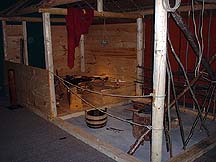
|
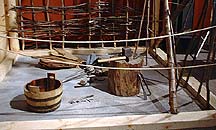
|
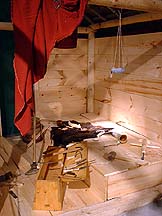
|
| Overview of the Town House... | consisting of Blacksmith's Shop.. | and Living Quarters |
Many of the new Norse towns started as seasonal camps, then over the years expanded to become permanent settlements that attracted not only traveling merchants, but a new class of Artisans. These craftsmen produced goods that could be bought with the silver profits from Viking raids. The Norse would either create new towns or expand existing ones throughout the areas where they had influence: Dublin in Ireland, York in England, Hedeby in what was south Denmark, Birka in Sweden. All of these have proved significant for the wealth of archaeological evidence they have given us about daily life in the Viking Age.
(21) Building : This is a composite design, based on the kind
of 'row houses' found at York, England and Birka, Sweden. Imagine this
building under construction in one of the new trade towns, the owner working
his trade by day and finishing the house in the evenings. The basic layout
remains the timber framed 'long house' (In this version scaled down slightly
from the archaeology, in York the houses were closer to 15 feet wide by
25 or more long. ) The interior is divided into two sections. The front
workshop, in this case for our blacksmith, is earth floored. The walls
are going to be woven willow saplings, called withy. Only one section is
close to completion, the front wall still has the pole cross braces in
place. The rear section has a plank floor, likely over top a dug out earth
basement for storage (a common feature at York). The walls here are more
snug wood planking, with a built in sleeping bench. Overhead a series of
poles are lashed together for the rafters, over this reed Thatching
is being placed to keep out the rain.
(Hedeby, Germany / 970 and York, England / 950's
pine, maple, reed thatch / assisted by David Cox)
(22) Withy wall, with Willow Pieces ready to weave into place.
These might be covered by a clay and manure mixture called 'daub'.
(Non Specific
various natural poles)
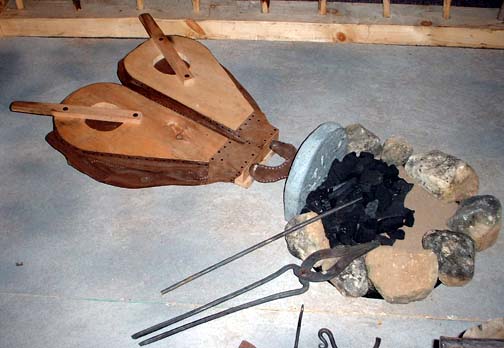
(23) Blacksmith's Forge: Charcoal was the only fuel used by the smith in the Viking Age. Huge amounts would be required, even a simple four inch knife would consume a pile that would fill a milk crate. Charcoal was created in the forest by specialized charcoal burners and traded or purchased by the smith in town. With good hardwood charcoal, it is possible to achieve welding temperatures in the 2400 degree F. range.
Bellows Stone : This soapstone block shields the bellows. In
use, the fire would be piled up against the stone. Typical fires are about
the size of a large apple in terms of effective heating area.
(Snaptun, Denmark / 1000
soapstone / artist : Anne Graham)
Tongs : For holding heated metal.
(Telemark, Norway / mid 900's
forged steel
Artifact in Full Circle)
(24) Bellows : The small two chamber type used in the Viking
Age. Our understanding of the shape and size of period bellows is based
on two carved images only. No bellows have survived from the period. Air
is conducted from the Bellows to the hole in the Bellows Stone by way of
short metal (or ceramic) pipes in this reconstruction linked by a leather
Y.
(Composite Design / Viking Age
pine, leather)
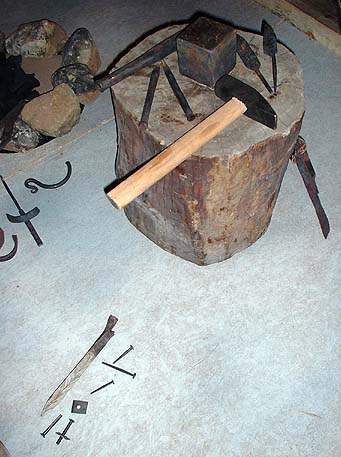
(25) Forged goods:
Rough Knife and Spear : This shows what the appearance
of 'rough forged' items would have been before polishing and finishing
(by hand!)
(Various / Viking Age
forged steel)
'Pattern weld' sample : The best weapons were formed using a
technique called 'pattern welding'. Layers of alternating hard and soft
iron were welded, pulled out, twisted, then welded again to a solid bar.
This bar would then form the core of a spear or sword. The alternating
layers of differing iron effectively formed a 'spring' at the center of
the weapon that allowed it to give slightly under combat impact, then spring
back, instead of breaking. Only a master smith could accomplish this technique.
(Non Specific / Viking Age
forged steel alloys)
(26) Anvil and tools:
Anvil on wood Stub : Viking Age anvils were small, about
15 - 30 lbs. This anvil is a typical size. (Note that the artifact in Full
Circle is actually a jeweler's anvil.) The anvil here is mounted at an
awkward height - too tall for working if kneeling, too short to work standing!)
(Telemark, Norway / mid 900's
forged steel
Artifact in Full Circle)
Hammer (Note that the artifact in Full Circle is actually a jeweler's
hammer.)
(Mastermyr, Sweden / 1150
reforged commercial, ash
Artifact in Full Circle)
Punches, for holes and cutting.
(Telemark, Norway / mid 900's
forged steel)
Nail Header, for spreading tops of nails and rivets. Link to
Ship Rivets, Nails
(Mastermyr, Sweden / 1150
forged steel)
Currency Bars : This is the shape that wrought iron was purchased
in. The blacksmith was unlikely to make his own iron from ore. The shape
suited function : The hole allows roping bars together for transport.
The square section is the usable material. The flat paddle shape is a test
of quality. Poor quality wrought iron tends to splinter when hammered thin.
A special note: These are the only forged objects in the exhibit that
are actually made of antique wrought iron. Compare the surfaces on the
flattened sections to see just the same quality test that is described.
(Buskerud, Norway / Viking Age
forged wrought iron
Artifact in Full Circle)
(27) Leather Apron.
(Non specific
cow hide)
Rivets: See description under Bondi.
(LAM, Canada / 1000
forged steel
Artifact in Full Circle)
Nails : Notice distinctive square pointed shape.
(LAM, Canada / 1000
forged steel
Artifact in Full Circle)
Cup : see description of Bowl under Bondi
(York, England / 900's
maple (?) / commercial)
(28) Slack Tub: see description of Bucket under Bondi
(Non Specific
oak, steel / commercial)
(29) Cloak : Rectangular cloaks were worn by both men and women.
One difference in style : Women clasped the cloak at the throat, while
men typically clasped the cloak under the right arm. This to expose and
leave free their sword arms.
(Non Specific
wool / artist : Vandy Simpson)
Iron Brooch : This simple circular broach is a reproduction of
one found at Novgrod, Russia. This type is called a 'pennannular' broach.
(Novgrod, Russia / 1000
forged steel)
(30) Oil Lamp : There are a number of examples of soapstone oil
lamps. Burning fish oil or fat with a small wick, these lamps cast a smoky
and dim light. Rather than thinking of these like modern lighting, compare
them to a 'night light'. Candles of bee's wax were expensive and not for
normal daily use.
(Shetlands / 1000
soapstone, leather / artist : Anne Graham
Artifact in Full Circle)
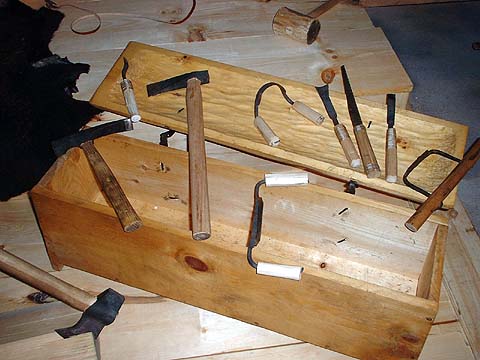
(31) Tool Box : This box is based on the Masterymr Tool Box,
found in Gotland, Sweden. The box contained a complete set of Blacksmith's
and Carpenter's working tools. It was found in isolation in a bog, an area
that had been a shallow lake in the Viking Age. One interpretation is that
it may have been dropped when an itinerant craftsman fell through thin
ice!
Note that all of these tools have been intentionally dulled for safe
handling.
(Mastermyr, Sweden / 1150
pine, steel / artist : Brad Markewitz)
Woodworking tools:
Fine Axe : For trimming timbers. Viking Age axes are all punched
from solid bar, rather than the folded and welded method common to the
Colonial period.
(Mastermyr, Sweden / 1150
forged steel, ash)
Adze, for detail shaping of joints and finishing planks.
(Mastermyr, Sweden / 1150
re forged commercial, maple)
Straight Draw Knife, for shaping handles and dowels.
(Mastermyr, Sweden / 1150
forged steel, maple)
Curved Scorp, for shaping bowls.
(Mastermyr, Sweden / 1150
forged steel, maple)
Saw: For detail cuts. Saws during the Viking Age are all small
fine tools. It was beyond the smiths' art to create the large saws we are
familiar with. See Split Log below.
(Mastermyr, Sweden / 1150
re forged commercial, maple)
Molding Scraper,: For cutting decorative edges. In the modern
age a router is used for this.
(Mastermyr, Sweden / 1150
forged steel, maple)
Chisels, straight, gouge, bent neck.
(Mastermyr, Sweden / 1150
forged steel, maple)
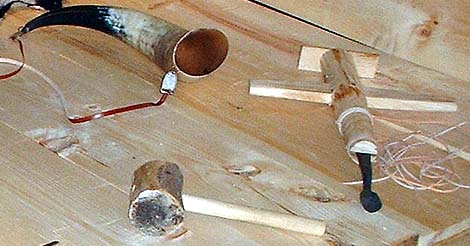
(32) Spoon Bit : In its holder, for boring holes. The size is
about right for boring the holes sued to fit the wattle upright poles into.
(Mastermyr, Sweden / 1150
forged steel, pine)
(33) Timber splitting with tools. The Norse split out planks rather than saw cutting them as we do. This requires a source of large, straight timber that is free from knots. The process is far faster than hand sawing. (Use of a pit saw in the latter Middle Ages could utilize much poorer quality timber.) Spit planks are far more flexible under load, making them ideal for ship hulls. Over the Viking Age there is clear indications from ship planking that much of the available good quality timber had been consumed.
Split Log and Planks, of pine and oak.
Felling Axe.
(Mastermyr, Sweden / 1150
re forged commercial, ash
Artifact in Full Circle)
Metal and wooden Wedges.
(Speculative
forged steel, maple)
Wood Mallet.
(Non Specific
maple)
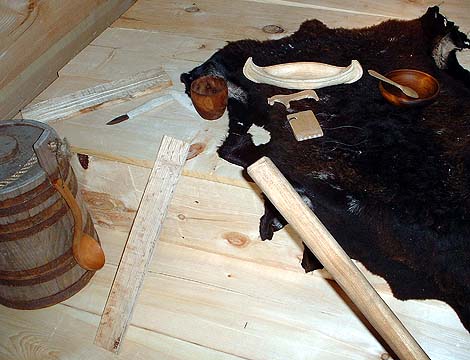
(34) Wood toys: The presence of a child?
Ship
(Greenland / Viking Age
pine / artist : Randy Markewitz)
Horse
(Trondheim, Norway / Viking Age
fir / artist : Randy Markewitz)
Pan Pipes, from York, England.
(York, England / 950
maple / artist : AG. Smith)
(35) Drinking Horn : see description under Bondi
(Non Specific
natural horn, leather, tin alloy)
(36) Wood Bowl : see Description under Bondi
(York, England / 900's
maple (?) / commercial)
Wood Spoon
(Non Specific
maple (?) / commercial with carving by S. Strang)
(37) Carving Knife : This is a specially formed carving tool.
It was normal for almost everyone to carry a simple knife. Men's versions
had the distinctive 'seax' shape, with its straight bottom edge. Women
were mare likely to carry a slimmer blade about four inches long (like
a modern paring knife).
(York, England / 900's
forged steel, antler)
Plank : Split maple with runes . The upper is the man's name
'Kettil' (KITIL). The lower is the 'FUTHARK' - the letters of the Norse
runic alphabet.
(Non Specific
maple)
(38) Water Pail : Clean drinking water was an extreme problem,
especially in the new Towns. Although these were almost all located on
rivers for transportation, a neighbour upstream was emptying slops buckets
(or worse) into the same stream you would draw your water from! See description
under Pail in Bondi.
(Non Specific
pine, steel / artist : Gary Stephens)
Ladle.
(Hedeby, Germany / 1000's
cherry (?) / commercial)
|
| for more information on the Viking Age... |